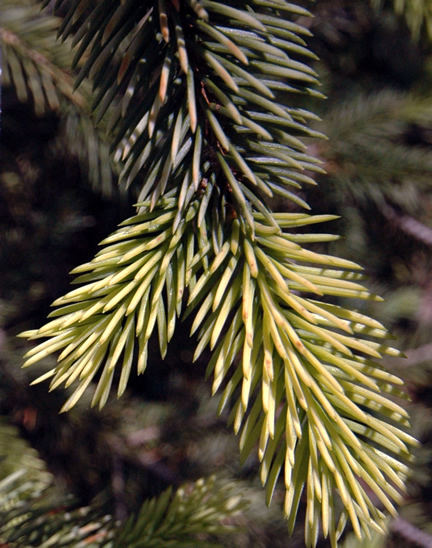| General Description | Tall pyramidal shaped tree with a vibrant gold colour to new growth. It bears large brown cones that form in the spring and drop off in the winter season. |
| ID Characteristic | Noticeable pyramidal form, with pendulous branches that seem to hang from the stem. Hanging brown cones are very large in size up to 15 cm. Stiff needles that have a soft touch to them with a light green to green colour. Bright gold needles closer to the termini of each stem instantly confirm its gold cultivated form. |
| Shape | Pyramidal shape as it matures while the branches maintain a pendulous habit of growth. |
| Landscape | Like its related partner species of evergreen it can be used as a screen for snow drifting or a windbreak along a property line. Needs room to grow and can provide sufficient shade. The ‘Early Gold’ cultivated form of this plant holds a sufficient amount more value and has been used as a eye-catching focal point in the landscape. |
| Propagation | Propogate by grafting off of mature plants. |
| Cultivation | Will grow in drier areas if deep moist soil is given. Prefers to be in Light sandy soils or even heavy clay soils as long as dampness and a cold temperature is maintained. A slightly acidic or neutral soil is best but can grow in soil with high acidity. A desired soil PH of 4 – 6 is a good guideline. It is shade tolerant but needs mostly full sun throughout the day. |
| Pests | Insect damage from spruce gall adelgids is common and easily identified by bulging stems close to the stem tip. When selecting your gold cultivar avoid any that seem dull with colour as they may lack nutrients. After all, these cultivars are desired for thier bright gold colour. |
| Habitat | Horticultural origin. |
| Bark/Stem Description | The bark overall has a brown colour contrast. Young trees have a pale look to them at times while mature trees have heavy bark with small scaly like texture, that will fall off to the touch. |
| Flower/Leaf Bud Description | Small Buds no bigger roughly 5-10 mm in length. These buds form an apex acute shape with small brown scales. |
| Leaf Description | 1- 3 cm in length with a slight rough stomata bearing foliage. These pine needles are light to green in most cases with solid bright yellow needles of new growth each spring. The needles growing on the apical dominance stem are tightly pressed and hugged around it. |
| Flower Description | Monoecious flowers in the leaf axils as well as pistillate flowers at the termini of each stem. Male flowers tend to grow in groups of a light brown colour and female flowers maintain a purple to pink colour. |
| Fruit Description | Light brown cones that can grow up to 15 cm long. Thin scaled cones with an irregular pattern. |
| Colour Description | Golden needles all year around with a mix of green colour foliage that may even appear slightly grey. This golden conifers early gold shoots are a very intense golden colour when they emerge. Cones and bark maintain a light brown to brown colour that gain a light grey appearance with maturity. |
| Texture Description | Tree with medium dense foliage. Needles have a slight shine to them and are very stiff with present stomata. Rough but otherwise flaky bark texture. |
